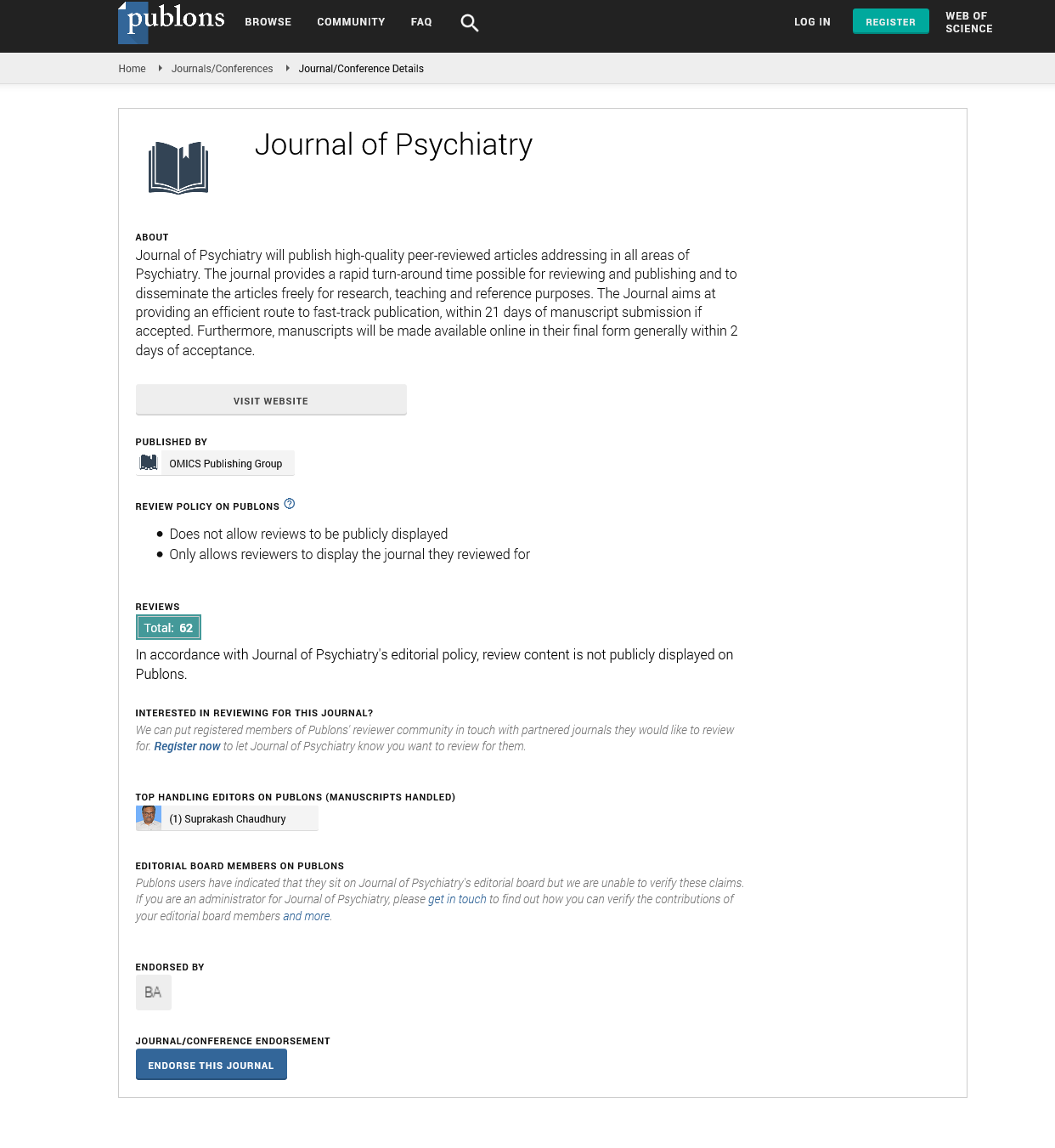Indexed In
- RefSeek
- Hamdard University
- EBSCO A-Z
- OCLC- WorldCat
- SWB online catalog
- Publons
- International committee of medical journals editors (ICMJE)
- Geneva Foundation for Medical Education and Research
Useful Links
Share This Page
Open Access Journals
- Agri and Aquaculture
- Biochemistry
- Bioinformatics & Systems Biology
- Business & Management
- Chemistry
- Clinical Sciences
- Engineering
- Food & Nutrition
- General Science
- Genetics & Molecular Biology
- Immunology & Microbiology
- Medical Sciences
- Neuroscience & Psychology
- Nursing & Health Care
- Pharmaceutical Sciences
Opinion Article - (2025) Volume 28, Issue 4
Neuroimaging Markers of Emotional Regulation in First Episode Schizophrenia
Zhang Ming*Received: 01-Jul-2025, Manuscript No. JOP-25-30176; Editor assigned: 03-Jul-2025, Pre QC No. JOP-25-30176; Reviewed: 17-Jul-2025, QC No. JOP-25-30176; Revised: 23-Jul-2025, Manuscript No. JOP-25-30176; Published: 31-Jul-2025, DOI: 10.35248/2378-5756.25.28.757
Description
Emotional regulation plays a crucial role in maintaining psychological well-being and functional capacity. In schizophrenia, especially during the first episode deficits in this domain can significantly hinder social and occupational functioning, heighten distress and increase the risk of relapse. As clinical attention increasingly shifts toward early intervention in psychotic disorders understanding the neural mechanisms underlying emotion regulation deficits becomes essential. This study aimed to investigate the brain activity patterns associated with emotional regulation in individuals experiencing their first episode of schizophrenia using functional Magnetic Resonance Imaging (fMRI) to examine both regional brain activation and connectivity between key neural structures. The research involved sixty participants in total thirty individuals diagnosed with first-episode schizophrenia and thirty healthy controls matched for age, gender and education level. All participants underwent fMRI scanning while performing an emotional regulation task that required them to actively down-regulate their response to negative emotional stimuli. The task was designed to simulate real-life emotional control processes and responses were measured at both the behavioral and neural levels. Additionally, participants completed standardized self-report assessments evaluating their perceived difficulties in emotion regulation in daily life.
Analysis of the neuroimaging data revealed clear differences in brain activation and functional connectivity between the patient group and the control group. Notably, individuals with first-episode schizophrenia demonstrated significantly reduced activation in the Dorso Lateral Pre Frontal Cortex (DLPFC) during the regulation task. The DLPFC is known to be a critical hub for executive functioning and top-down control of emotional responses. Lower activation in this area suggests that individuals with schizophrenia may struggle to recruit the necessary cognitive resources to manage negative affect effectively. In addition to reduced prefrontal activation patients also exhibited weaker functional connectivity between the amygdala and the ventromedial Pre Frontal Cortex (vmPFC). The amygdala is primarily responsible for detecting and responding to emotionally salient stimuli, while the vmPFC plays a regulatory role modulating the intensity of emotional reactions generated by the amygdala. The observed reduction in connectivity between these two regions suggests a disruption in the neural pathways that support the modulation of emotional responses a pattern that may underlie some of the emotional dysregulation commonly reported in early schizophrenia.
Importantly, the degree of reduced connectivity between the amygdala and the vmPFC was significantly correlated with participants self-reported challenges in regulating emotions in everyday life. This relationship provides converging evidence that the observed neural alterations are not merely laboratory artifacts but have real-world implications for the emotional functioning of individuals with early psychosis. These findings enhance our understanding of the biological substrates of emotional difficulties in schizophrenia and highlight the relevance of brain-based markers in guiding clinical assessments and interventions. From a clinical standpoint, these results offer potential applications for the development of personalized treatment plans. Identifying patients with particularly pronounced neural deficits in emotion regulation could help clinicians determine who might benefit from more intensive psychosocial support such as cognitive-behavioral therapy, mindfulness-based stress reduction, or emotion-focused therapeutic approaches. Neuroimaging assessments, while not yet standard in psychiatric practice may one day assist in tailoring treatment intensity and focus according to individual neural profiles.
Moreover, these neural patterns could serve as valuable biomarkers for tracking therapeutic response over time. For instance, future longitudinal studies might examine whether improvements in emotion regulation abilities following therapy are accompanied by changes in DLPFC activation or amygdala vmPFC connectivity. If such neural alterations can be linked with positive clinical outcomes they could serve as objective indicators of treatment efficacy and inform early modifications to intervention strategies. It is important to acknowledge the limitations of the current study. The sample size, though adequate for initial insights, was relatively modest and may not capture the full variability present in the broader population of individuals with schizophrenia. Additionally, the cross-sectional design restricts conclusions about causality. While associations between brain function and emotional regulation were identified, it remains uncertain whether the neural abnormalities preceded the onset of psychotic symptoms or emerged as a consequence of the illness. Longitudinal research will be essential to clarify these developmental trajectories and to determine whether early therapeutic interventions can reverse or mitigate the neural impairments associated with emotion regulation deficits.
In conclusion, this study provides compelling evidence of altered brain activation and disrupted connectivity patterns related to emotion regulation in individuals experiencing a first episode of schizophrenia. The findings emphasize the importance of integrating neurobiological insights into clinical practice and point toward the potential utility of neuroimaging in enhancing early intervention efforts. As research progresses understanding the neural architecture of emotional control may lead to more targeted, effective treatments that address not only the cognitive and psychotic symptoms of schizophrenia but also the emotional challenges that contribute to long-term disability and relapse.
Citation: Ming Z (2025). Neuroimaging Markers of Emotional Regulation in First Episode Schizophrenia. 28:757.
Copyright: © 2025 Ming Z. This is an open-access article distributed under the terms of the Creative Commons Attribution License, which permits unrestricted use, distribution and reproduction in any medium, provided the original author and source are credited.

